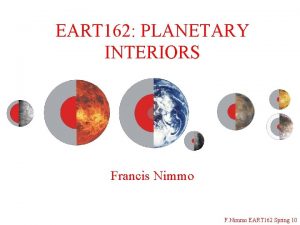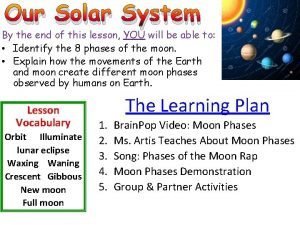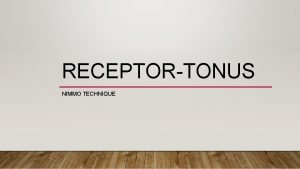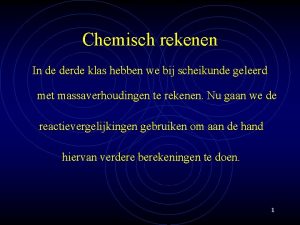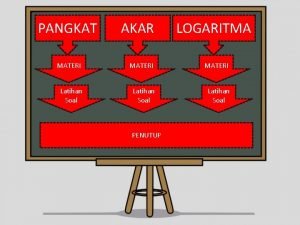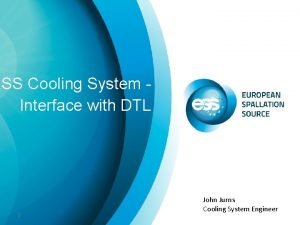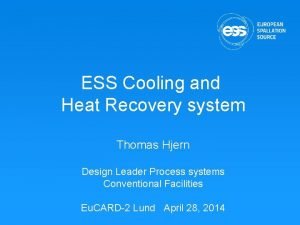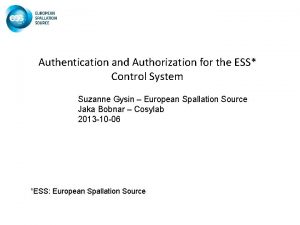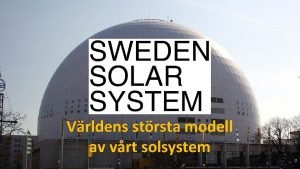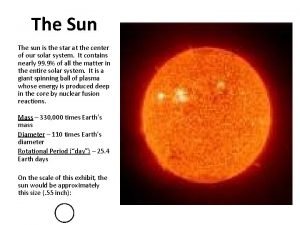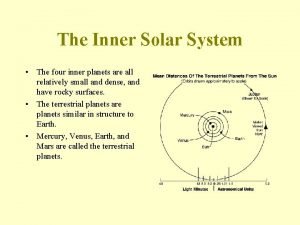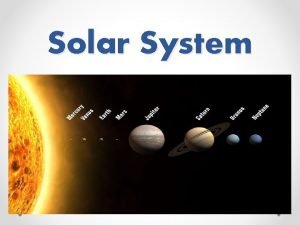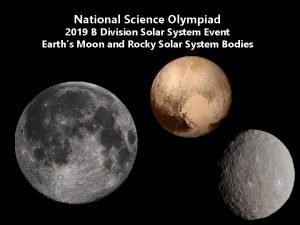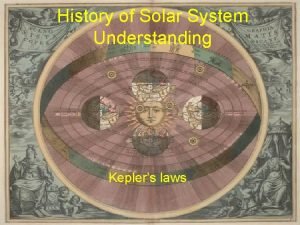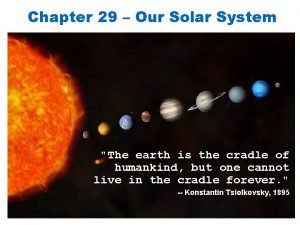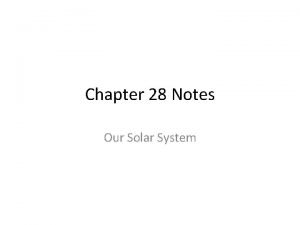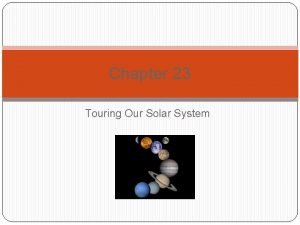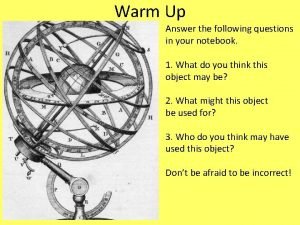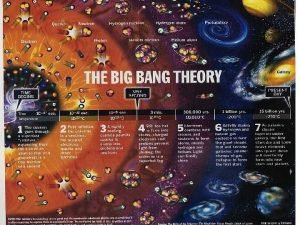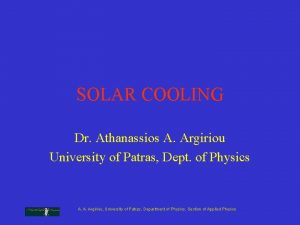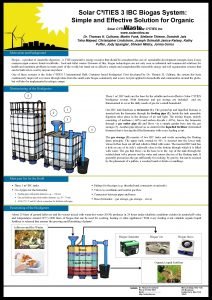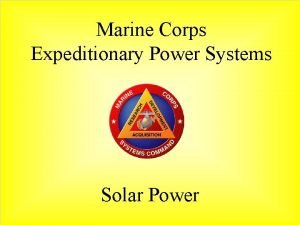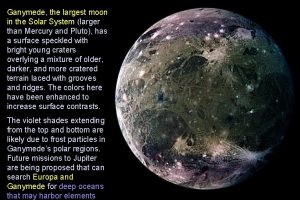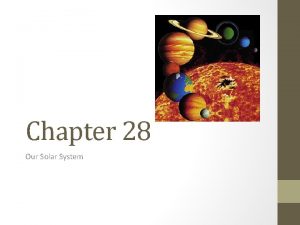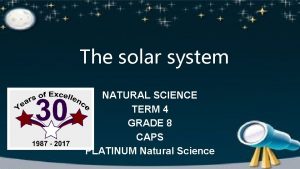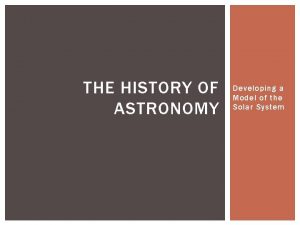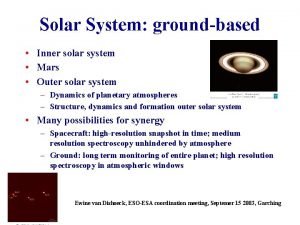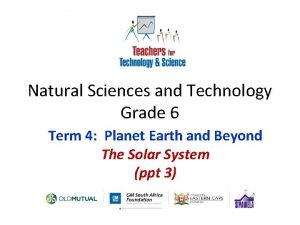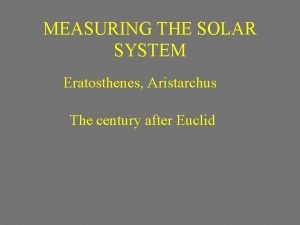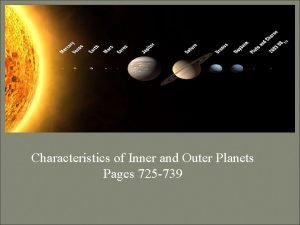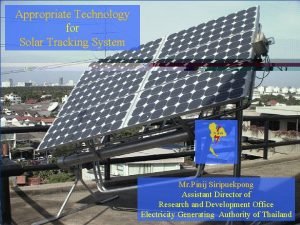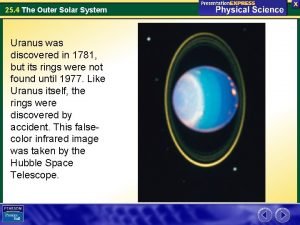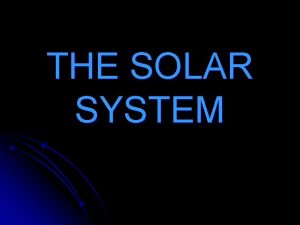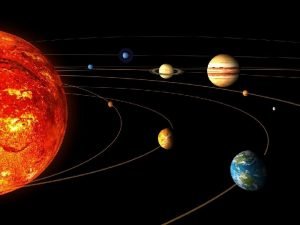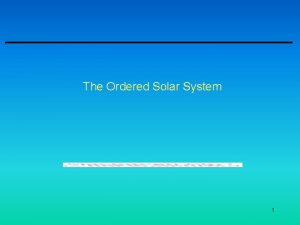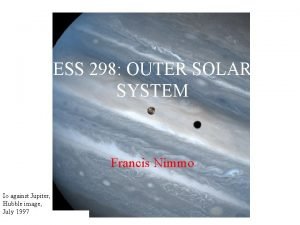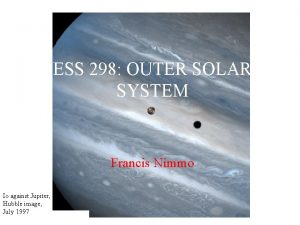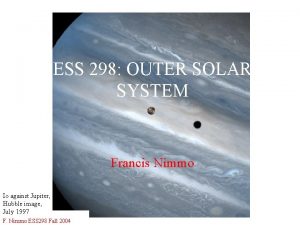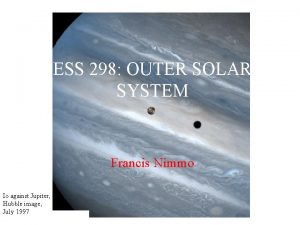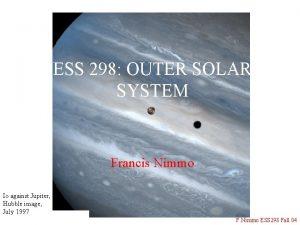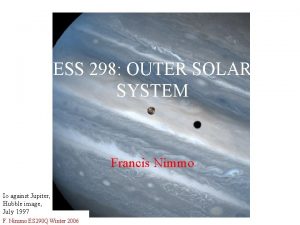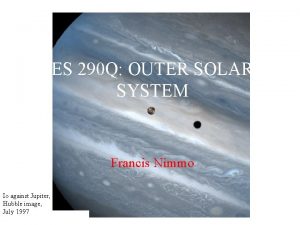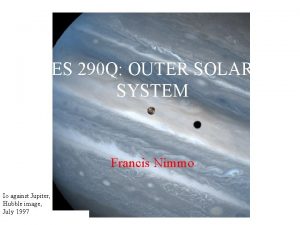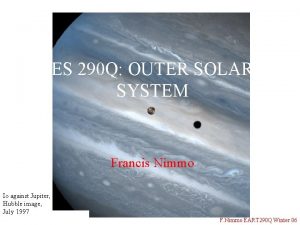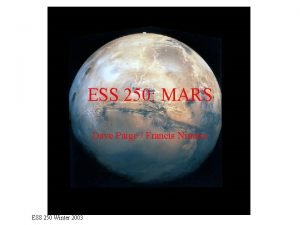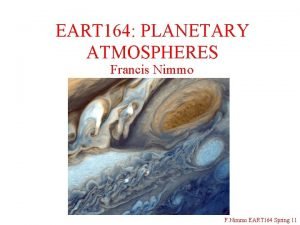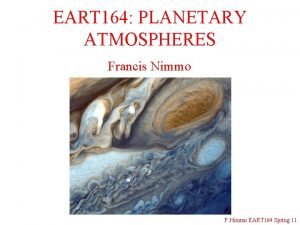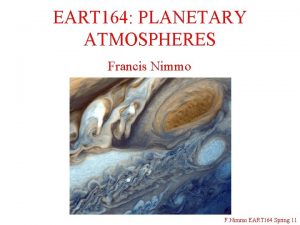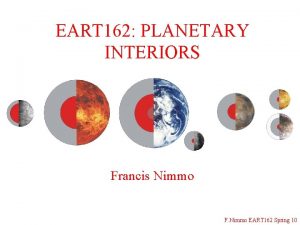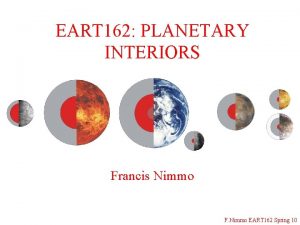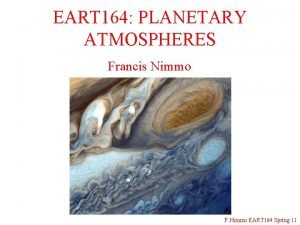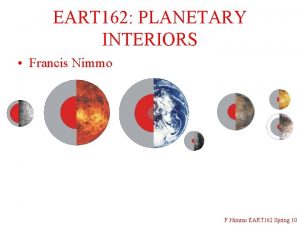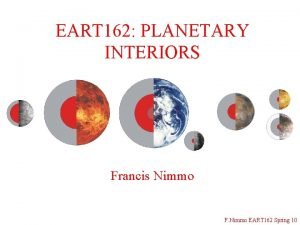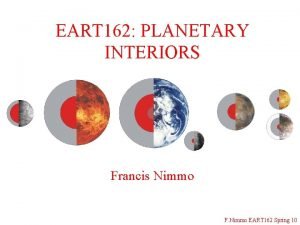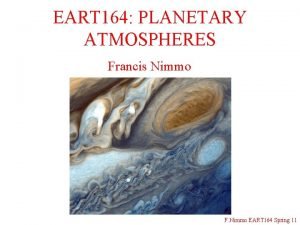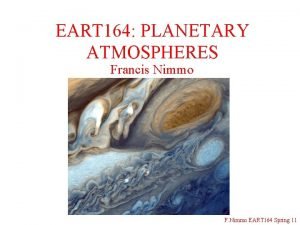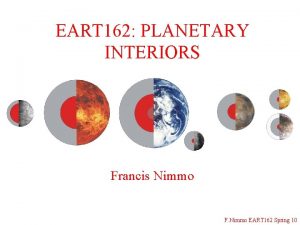ESS 298 OUTER SOLAR SYSTEM Francis Nimmo Io






























































- Slides: 62

ESS 298: OUTER SOLAR SYSTEM Francis Nimmo Io against Jupiter, Hubble image, July 1997

Titan and Other Satellites • Titan (largest moon of Saturn) – Atmosphere – Surface – Interior – Cassini • Other Satellites of Saturn and Uranus

Why is Titan important? • • • It has a thick atmosphere (unique amongst satellites) Large (Mercury-size) Surface currently unknown (haze) Astrobiologically interesting (hydrocarbons/organics) Current exploration – Cassini/Huygens Titan

Basic Parameters Ganymede Titan Callisto a (Rp) 15. 0 20. 3 26. 3 Period (days) 7. 16 15. 9 16. 7 Eccentricity 0. 0015 0. 0292 0. 007 Radius 2634 2575 2400 Density 1. 94 1. 88 1. 85 C/MR 2 0. 311 - 0. 355 Tsubsolar 156 94 168 g (m s-2) 1. 43 1. 35 1. 24 Psurface (bar) - 1. 5 - • The surface has been imaged only at very low resolution • No data on magnetic field, Mo. I etc. – as yet! Rp is planetary radius, 71492 km for Jupiter, 60268 km for Saturn

Why an atmosphere? lay ze Ha – Local nebular temperatures sufficiently cold that primordial atmosphere was able to form (Saturn is ~ twice as far from Sun as Jupiter, and is less massive) – Titan’s mass sufficiently high that it was able to retain a large fraction of this original atmosphere (and later cometary additions) (Jeans escape) – Surface temperature warm enough to prevent some volatiles (e. g. N 2) freezing out (c. f. Pluto, Triton) er • Titan is the only satellite to have a significant atmosphere. Why? • Seems to be a combination of three factors:

Jeans Escape • Escape velocity ve= (2 g R)1/2 (where’s this from? ) • Mean molecular velocity vm= (2 k. T/m)1/2 • Boltzmann distribution – negligible numbers of atoms with velocities > 3 x vm • Nitrogen N 2, 94 K, 3 x vm= 0. 7 km/s • Titan ve=2. 6 km/s • A consequence of Jeans escape is isotopic fractionation – heavier isotopes will be preferentially enriched • Titan has a D: H ratio in its methane of about 6 times that of Jupiter and Saturn. Half of this is due to Jeans fractionation, but the remainder is probably due to cometary additions to the atmosphere (comets have higher D: H than solar)

Atmospheric Composition • • N 2 CH 4 O 2 Titan 82 -99 % 2 -10 % - Earth 78% 2 ppm 21% CO 2 Ar 0. 01 ppm < 1 -6 % ? 350 ppm 0. 9% Surface pressure 1. 5 bar, temperature 94 K Obtained from UV/IR spectra and radio occultation data Various organic molecules at the few ppm level Haze consists of ~1 mm particles, methane condensates plus other hydrocarbons (generated by photodissociation and recombination of methane; similar to Los Angeles smog) • These particles eventually rain down to the surface where they will condense (ethane will be liquid)

Atmospheric Chemistry • Methane gets photodissociated and H 2 is lost (why? ): • Reactants e. g. ethane will condense and fall to the surface • These two effects mean that the lifetime of methane in the present atmosphere is ~107 yrs • So there must be something which is continually resupplying methane to the atmosphere • One suggestion was that this source was a methane ocean at the surface • Methane liquefies at 90. 6 K, ethane at 101 K, c. f. surface temp. 94 K • There are other possibilities e. g. comet delivery, outgassing • Atmosphere is reducing because of lack of oxygen. Where is the oxygen? It’s locked up in solid H 2 O at the surface (c. f. Earth, Mars). • This in turn means there’s little CO 2

Atmospheric Processes Photodissociation Hydrogen escapes Ethane condenses at 101 K Other reactants similarly Clouds Methane recharge Organic drizzle Underground aquifer? Ethane etc. ponds? After Coustenis and Taylor, Titan, 1999 • Theories suggested ethane ocean could 0. 5 -10 km deep • But current observations find very little evidence for a global ocean (see later)

Atmospheric Structure • At lowest temperature (tropopause) all constituents except N 2 are condensed (clouds) • For an adiabatic atmosphere we have d. T/dz=mg/Cp (derived in next week’s lecture) • For an N 2 atmosphere, m=0. 028 kg, Cp~3. 5 R=30 J K-1 mol-1 • So the lapse rate is ~1 K/km • Temperature increases above tropopause due to incoming solar radiation • Particulate haze makes direct observations of clouds hard Particulate haze extends to ~300 km Lapse rate ~1 K/km From Owen, New Solar System

Clouds • Clouds lie beneath the haze layer, at 10 -20 km, and are mainly methane crystals (bright) Predominance of clouds near S pole not yet explained but may be due to local convective columns driven by small changes in surface temperature. Keck Adaptive Optics images, from Brown et al. Nature 2002 Cassini image of clouds near South Pole 450 km

Is there really a surface ocean? • Sagan and Dermott (Nature 1982) presented a very clever argument against a surface methane ocean, using Titan’s orbital evolution • Titan’s current eccentricity is relatively high (0. 029) • This eccentricity is not (currently) being excited by anything else, so it is presumably ancient • But any dissipation in Titan will tend to circularize the orbit (see Week 1), at a rate governed by 1/Q • The effect of a shallow surface ocean is to greatly increase the dissipation, reduce Q, and lead to an eccentricity damping timescale much shorter than the age of the solar system • So either the ocean is very deep and global, or it is small or nonexistent.

Is there really a surface ocean (2)? • Although Titan’s clouds are opaque at most wavelengths, there are transparent “windows” (see arrows) which allow the surface to be viewed • The images on the right were taken by Hubble at 0. 85 -1. 05 microns (mm), and show variations in surface reflectivity. • Clearly, there is not a global ocean • The images also suggest that Titan is rotating (approximately) synchronously 1. 07 mm 1. 6 mm 1. 28 mm 2. 0 mm Sub-Saturnian Images separated by 90 o Anti-Saturnian

Is there really a surface ocean(3)? • Titan is the most distant object to date imaged with radar • Original results showed radar-bright and –dark regions • Radar surface reflectivity is 5 -25%, much more than expected ocean values (2%) but less than values for icy Galilean satellites (30 -90%). Perhaps the surface is an ice-rock mixture? • Recent radar results (Campbell et al. Science 2003) found both diffuse and specular reflections. They suggest the specular reflections are consistent with bodies of ethane/methane liquid, but there are other possible alternatives e. g. very smooth ice regions. diffuse Surface roughness ~ radar wavelength (13 cm) specular

Surface Spectra • Clever technique – use “windows” in atmosphere (see earlier slide) to obain reflectance spectra of surface • Note that even in these windows, one still has to correct for scattering by haze particles Titan observations Haze optical depth leading trailing Griffith et al. Science 2003 Results strongly suggest water ice is a dominant component. “Tholins” (organic material) appear to be relatively minor

What is the surface going to be like? • Predominantly icy, plus a coating of organics • Cratered (small ones missing – why? ) • Tectonized? What are the sources of stress? • Volcanism? • Tempting to assume that the bright areas are high (methane snow? ) • Windy? Not at the surface. Thick attmosphere means small temperature gradients, so weak Cassini false-colour NIR composite winds (~1 m/s? ) image. Yellows are hydrocarbons, green is ice, white is methane clouds • Dark – bright moonlit night

Interior Structure • Essentially unknown right now – density constraint • Cassini will help things • Main questions: – 1) Is it differentiated? (Ganymede vs. Callisto) – 2) Is there an ocean? (Why will detecting an ocean be much harder at Saturn than at Jupiter? ) – 3) Are there volatiles (other than water) present at depth? • Volatiles? – Two main ones are CH 4 and NH 3 – Clearly present in the atmosphere, but may also be present at depth – other Saturnian satellites are inferred to have them on the basis of recent geological activity – Were they stable during Titan’s formation? Quite likely, but depends on poorly known details of nebula

Volatile Effects Pressure, GPa • Ammonia has a dramatic effect on the melting temperature of water ice – much easier to get oceans • Ammonia: methane ratio ~1: 1 in solar nebula 0. 2 ice 0. 4 0. 6 Ice + 5% NH 3 0. 8 1. 0 180 230 Temperature, K 280 After Grasset et al. , Planet Space Sci. , 2000 • Methane will form clathrate structures with water of the form NH 3. 6 H 2 O. These structures are stable up to at least 10 GPa (Loveday et al. , Nature 2001) and provide an efficient way of storing large volumes of NH 3 in the subsurface. Similar clathrates are found on Earth.

Possible Structures • Undifferentiated – Pro – distant from Sun and Saturn, no likelihood of tidal heating – Con – incorporation of volatiles makes melting easier • Differentiated but no ocean – Pro – hard to avoid differentiation (Callisto? ) – Con – hard to freeze ocean completely if NH 3 present • Differentiated with ocean – Pro – likely end state if NH 3 present – Con – no tidal heating (c. f. Ganymede), dissipation may create problems • How might we test these models?

Cassini • 6 tonnes, ~$2 bn, launched in 1997, planned from 1985 • Note the absence of scan platform (so what? ), and the reaction wheels • Trajectory included Venus and Earth flybys, and will flyby Titan 44 times

Instruments • Most interesting one is the radar (uses the same system as the communications radio – whole spacecraft has to reorient itself!) • Will produce images of the surface at ~1 km resolution in ~100 km wide swaths • Also does altimetry, ~25 km spacing, and measures backscatter 55 km Approx. altimetry footprint Left-hand image is of Ganymede with resolution (1. 3 km/pix) comparable to Cassini radar resolution. Right hand image is from Galileo, 75 m/pix Schematic of radar coverage. Two side-looking image swaths and a central altimeter pulse. Minimum altitude of spacecraft is ~1000 km. From Elachi, Proc. IEEE, 1991

Huygens • Probe launches on Dec 25, 2004 • Communication problems! • Main chute has to be jettisoned to prevent probe falling too slowly (and freezing) • Designed to survive on surface for ~1/2 hr, and to float • Instruments: – – – Imaging system Wind measurements Aerosols PT sensors Surface package GCMS

Two Afterthoughts • Why is Titan so exciting? – One reason is that it may in some respects resemble the earliest Earth, before life was established. Obviously there are differences (e. g. temperature) but Titan may be the best example of what the “primordial soup” (more accurately, gazpacho) which gave rise to terrestrial life looked like – Another reason is we have no idea (yet) what the surface will look like. Will it resemble Ganymede, Callisto, Triton, or somewhere else entirely? • Cassini’s First Titan flyby – TODAY! 6: 30 pm NASA TV

Mid-sized satellites

Rogues’ Gallery

Common Themes • Tidal heating and orbital evolution (Peale Annu. Rev. Astron. Astrophys. 1999 is a good reference) • • • Role of volatiles (ammonia, methane) Size-related effects Impact crater populations and effects Effect of distance from primary Lack of simple explanations. . .

Saturn Uranus a (Rp) T (days) e R R (km) (g/cc) Notes 3. 08 0. 94 0. 02 196 1. 14 res. Tethys Enceladus 3. 95 1. 37 0. 0045 250 1. 12 res. Dione Tethys 4. 89 1. 89 0. 00 530 1. 00 res. Mimas Dione 6. 26 2. 74 0. 0022 560 1. 44 res. Enceladus Rhea 8. 74 4. 52 0. 001 1. 24 Titan 20. 3 15. 9 0. 0292 2575 1. 88 Hyperion 24. 5 21. 28 0. 1042 ~100 chaotic res. Titan Iapetus 59. 1 79. 3 0. 0283 718 1. 02 Miranda 5. 18 R 1. 41 0. 0027 242 1. 20 Ariel 7. 65 R 2. 52 0. 0034 579 1. 67 Umbriel 10. 7 R 4. 44 0. 0050 586 1. 40 Titania 17. 5 R 8. 71 0. 0022 790 1. 71 Oberon 23. 4 R 13. 5 0. 0008 762 1. 63 14. 3 R 5. 88 1. 6 e-5 Mimas Neptune Triton 764 1353 1. 64 res. Hyperion Inc. 15 o

Things to Notice • Jupiter has 4 large (>1500 km) moons, Saturn 1, and Uranus and Neptune none. Why? • Neptune appears to be moon-poor in general. Why? • All are synchronous, except Hyperion (chaotic) • Densities are all close to 1 g/cc, suggesting mainly volatile ices (see next slide). Uranian satellites are denser. • Uranus satellite densities increase (roughly) with distance. Why? • Several of the periods are close to (or actually in) resonance e. g. Mimas-Tethys, Iapetus-Titan. May have had significant effects earlier in history. • Uranian system has no resonances (at present day)

Eccentricity Damping • Several of the satellites have eccentricity damping timescales t much less than the age of the solar system: Satellite Miranda Ariel Umbriel t (Myrs)* Satellite t (Myrs)* 200 100 700 Mimas 300 Enceladus 600 Tethys 100 Titania Oberon 5000 40, 000 Dione Rhea 500 1000 *Here we are assuming Q=100; figures from Dermott et al. Icarus 1988 • This is problematic: either their eccentricities were recently excited, or the damping timescales (and thus the assumed interior structures) are incorrect. See later.

From Morrison et al. , in Satellites, 1986 Densities/Radii Uranus Neptune (Triton) Pluto/Charon Theoretical lines • Model density increases with increasing radius (why? ) • Saturnian satellites are probably >60% ice • Uranian satellites are denser on average, and Triton, Pluto and Charon are denser again (why? ) Condensation sequence (Week 1) favours CO, N 2 (volatile) at high temps, CH 4, NH 3 (ice-forming) at lower temps. But if cooling is too rapid, CH 4 and NH 3 may not have time to form (kinetics). So where cooling is slower, more ices form, resulting in lower overall density.

Albedos • Callisto and Uranian satellites are dark, Saturnian satellites bright (except parts of Iapetus) • If anything, albedo decreases with radial distance (why? ) • Uranian satellites are denser on average than Saturnian

Cratering and Ages • Cratering rate increases with decreasing distance to primary (grav. focusing), e. g. x 2 at Rhea, x 20 at Mimas compared with Iapetus (Smith et al. Science 1982) • Size of crater caused by particular object increases with decreasing distance to primary • So observed crater density is a strong function of distance to primary as well as surface age • This makes even relative cratering ages hard to determine and model-dependent, never mind absolute cratering ages (see Zahnle et al. Icarus 2003) • A consequence of gravitational focusing is that objects near the primary may have been disrupted once or several times by impacts (Mimas, Enceladus, Miranda, Ariel)

Data and Models Model impact rate Observed crater density Only highest densities are plotted here • Note that model impact rate decreases with increasing distance – high crater density can still mean young surface if the satellite is close to the primary • Considerable scatter in observed crater densities Open circles denote extrapolations

Non-synchronous rotation (? ) • The satellites of Uranus and Neptune are expected to show large (6 -35 times) variations in crater density from leading to trailing hemisphere if they have rotated synchronously for 4 Gyrs • None of them show such a signature. Why not? • Possible that large impacts (~20 km diameter crater) are sufficient to break the synchronous lock (see Chapman and Mc. Kinnon, in Satellites, 1986) • There should still be an asymmetry in recent (small) impacts, but these are not visible with Voyager images • Note that Iapetus does show a leading/trailing hemisphere asymmetry in albedo, suggesting that it is synchronously locked at the present day

Absolute Ages (? ) From Zahnle et al. Icarus 2003 • Uncertainties in absolute fluxes mean surface ages are very uncertain. • Iapetus, Oberon, Titania and Umbriel are undoubtedly very old • Mimas and Enceladus are at least slightly, and perhaps much, younger • Parts of Miranda are very young • Several satellites show a wide spectrum of ages (Enceladus, Rhea, Ariel)

Activity (? ) • Tectonic activity is relatively easy to infer • Cryo-volcanic activity is much less easy to identify (e. g. Galilean satellites post-Galileo) • Crater counts provide relative levels of activity • Crater relaxation is an indication of increased heat flux 670 km scarp Crater counts showing surface age diversity Kargel and Pozio Icarus 1996 Close-up of Miranda rift, showing large fault scarp (~5 km high)

Expansion(? ) • As with Galilean satellies, almost all tectonic activity appears to be extensional – why? • If satellites started cold (slow accretion) then release of radiogenic heat could generate heating and expansion (~1%) • Tidal heating could also similarly generate extension • Alternatively, as an ocean freezes and converts to less dense ice I it will generate extension (NB this does not work if it forms higher density ice phases, so only applicable to small satellites (P<200 MPa))

Volatiles • There is currently no direct evidence of ices such as ammonia or methane on the satellites of S, U, N • But there are reasonable theoretical grounds for expecting them to be there – Likely nebular temperatures consistent with their formation – Presence of ammonia (especially) helps explain observed geological activity – Titan’s atmosphere does have N 2 and methane • Methane forms a clathrate structure with H 2 O when the latter is present at the correct P, T conditions. Such clathrates may form a reservoir e. g. for Titan’s atmosphere.

Ammonia From Kargel, in Solar System Ices, 1998 • A mixture of ammonia and water doesn’t completely freeze until 178 K • As freezing continues, the remaining liquid becomes more ammoniarich • The low temperature of this liquid may prevent convection (DT small) This ammonia-rich liquid is usually denser than pure ice, but less dense than NH 3. 2 H 2 O, so that it is likely to be able to ascend and erupt - cryovolcanism

Saturn Observations Small (<500 km), inactive Note absence of craters Herschel Mimas R=196 km Small, active Enceladus R=250 km Note hemispheric albedo contrast Dione R=560 km Iapetus R=718 km Tethys R=530 km Ith Ch aca asm a Rhea R=764 km Medium, inactive Medium, active

Uranus Observations Small (<500 km), inactive Small, active Miranda, R=242 km Titania, R=790 km Umbriel, R=586 km Oberon is so poorly imaged that it’s not clear how active it is Medium, inactive Ariel, R=579 km Medium, active

Activity Summary I III E M II II T D I R II A U T I P T N I P I II III H T I II/III M I O • “Metamorphic grade” of planet, based on cratering observations and tectonic history (Johnson, in Solar System Ices, 1998) • I=“Unmodified”, II=“Intermediate”, III=“Heavily modified”

Tidal Heating (1) • Enceladus is small but active, and currently in a resonance with Dione – differential orbital expansion similar to Io (? ) • So likely that tidal heating is responsible, but details are unclear (Squyres et al. Icarus 1983). In particular why did Enceladus melt if Mimas didn’t? (Mimas is in a 2: 1 resonance with Tethys) • Mimas is also puzzling because its eccentricity is high (how? ) while at the same time it shows no sign of tidal deformation • Ariel (also small and active) is not in a resonance now, but may have been (e. g. with Umbriel) in the past. How? • The same also goes for Miranda (tiny and active). The fact that Miranda’s orbit is inclined at 4 o is also suggestive of an ancient resonant episode (Tittemore and Wisdom, Icarus 1989) • As with Ganymede, orbital evolution may explain present-day features. . .

Tidal Heating (2) Ariel’s orbit expands faster than Miranda’s because Ariel is so much more massive 3: 1 resonance responsible for Miranda’s present-day inclination (? ) • Theoretical evolution of orbits (from Murray and Dermott; c. f. Dermott et al. Icarus 1988) • Note that various resonances may have been encountered on the way to the presentday configuration (e. g. Miranda: Umbriel 3: 1) • Passage through resonance will have led to transient eccentricities and heating • Note that diverging paths do not allow capture into resonance (though they allow passage through it), while converging paths do. This may help to explain why there are no examples of resonance in the Uranian system.

Other effects? • Tides can’t be the only answer e. g. – Umbriel not resurfaced, though it likely went through resonances – Titania is resurfaced, but no resonance has ever been identified – Some of the resonances do not generate much tidal dissipation e. g. Ariel: Umbriel 2: 1 resonance • One suggestion is that inner bodies were catastrophically disrupted by impacts, and then reaccreted. The energy of this reaccretion might help to explain early activity. – How then do we explain Mimas? Close in, but not active. • What about gradients in the initial nebula? Might expect more geological activity at smaller distances, where more volatiles had time to condense. – Not really borne out by observations (e. g. Umbriel v. Titania)

Example - Enceladus Tectonized crater Extensional faulting • Looks like a miniature Ganymede, including relaxed craters and extensional faulting • Wide variety of surface ages, some <~107 yrs • May be the source of the E ring, which has a lifetime of only ~104 yrs • High albedo, perhaps suggestive of recent activity and frosting? 50 km Cassini, July 2004

Enceladus – cont’d • Early deformation could be due to initial freezing and expansion, but there has been much more recent activity • Current eccentricity generates ~0. 1 m. Wm-2, comparable to radiogenic, insufficient to account for activity • Increase in e by ~10 times would be sufficient to explain activity. What could have caused such an increase? Not clear – current resonance with Dione insufficient • Increase in eccentricity must be relatively recent: eccentricity damping timescale ~108 yrs. • Mimas also presents a problem – why does it show no signs of activity when it’s closer to Saturn? • See Squyres et al. , Icarus 1983 for a lucid discussion

Other Oddities 1 – Miranda’s Coronae Elsinore corona 480 km 300 km • Roughly circular, large tectonic features with extensional faulting on their margins • Topographic profiles suggest flexure and Te~2 km • What are they? Maybe upwellings, but no-one really knows. . . 100 km Rift flank profile (c. f. Ganymede) What’s the naming theme? Limb of Arden corona From Pappalardo et al. , JGR 1997

Other Oddities 2 – Iapetus Dichotomy 1400 km Cassini, 2004 bright dark Voyager, 1981 • Albedo varies from ~0. 5 (ice) to ~0. 05 from one hemisphere to the other • The dark side is centred on and symmetrical about the leading hemisphere. Why? Two explanations: • 1) Impacts on Phoebe generate dust which eventually spirals in and impacts on the leading hemisphere • 2) Dark material is produced internally and then concentrated on the leading hemisphere e. g. by impacts removing a bright frost covering • Symmetry suggests NSR is not happening

Other Oddities 3 - Phoebe Dark surface material Underlying bright material (ice? ) 150 km Cassini images 45 km • Small (D~200 km), dark, retrograde, eccentric (0. 16) and far (215 Rp) • Most likely a captured object (from where? ) • Albedo (~0. 05) comparable to dark side of Iapetus • Where does the dark material come from? • High-res images suggest dark and light layering

Conclusions • There is a surprising amount of activity for such small satellites • The energy source for this activity must be tidal heating (though the details are usually obscure) • The presence of low-melting temperature species like ammonia is almost certainly required to allow the activity to happen, though there is little evidence of cryovolcanism • Impacts have had significant effects in disrupting, spinning and eroding satellites • Distance from primary seems to be a secondary control on satellite characteristics • Extension is dominant

Student Presentations • Sign-up sheet – my office (4642), today, 2 pm • List of topics on the website (or you can pick your own – anything controversial and current) • If you like you can do it in pairs – pro and con • 70% of final grade • Weeks 8 & 9 – 20 mins. + 5 mins. discussion • Come and talk to me if you’re not clear on what’s required

End of Lecture Supplementary material follows

Measuring the Winds (from Earth!) • This is a very clever technique, which involves serendipity (an unexpected binary star), adaptive optics, and some (fairly) simple theory • The basic technique is to use an occultation (i. e. when a star (or a spacecraft) passes behind a planet as viewed from the Earth): star atmosphere planet Earth “Central Flash” The occultation has three effects: 1) The intensity of the light decreases (this is easy to measure) 2) The angular deflection of the star increases (this is usually impossible to measure) 3) The refraction leads to a “central flash” as the star passes behind the centre of the planet. If the atmosphere is not perfectly axisymmetric, other refraction effects are observed and can be used. . .

Binary Occultation • When the 20 Dec 2001 occultation of Titan was observed (using adaptive optics), it was realized the star was binary. Why was this helpful? • 1) It allowed the angular deflection to be measured, and the location of the refracted starlight to be tracked • 2) It allowed the changes in intensity to be measured very accurately (by referencing to the unobscured star) Titan (zeroed out) Refracted starlight Figures from Antonin Bouchez thesis, Caltech

Modelling • The intensity and angular deflection of the refracted starlight allow the shape of a surface of constact refractivity (=pressure) in Titan’s atmosphere to be established – the atmosphere acts as a lens • Assuming an isothermal atmosphere, variations in the height of a constant pressure surface have to be balanced by zonal (horizontal) winds • The inferred winds are not symmetric about the equator – this is probably due to seasonal variations in heating as a result of Titan’s obliquity (27 o). Wind velocities are also high (~100 ms-1) Atmosphere (schematic) Winds Atmos. surface altitude varying with latitude Resulting winds

“. . . A reddish colour dominated everything, although swathes of darker, older material streaked the landscape. Towards the horizon, beyond the slushy plain below, there were rolling hills with peaks stained red and yellow, with slashes of ochre on their flanks. But they were mountains of ice, not rock. . . ” Stephen Baxter, Titan

Size effects • • • Radiogenic heat flux goes as R Cooling rate also decreases as R increases But tidal heating is more affected by e than R Central pressure = 2 Gp. R 2 r 2/3 (why? ) Ice converts from I-II at 200 MPa so critical radius for this conversion to occur is ~800 km cooling Cooling of large satellite will lead to ice I-II transformation, which causes large change decrease in radius and thus global compression

Size Effects - Examples • Compression effect of Ice I-II transformation may explain why Iapetus and Rhea (slightly larger) are less active than Dione and Tethys – compression suppresses volcanism and extension. Some evidence for compressive features on Rhea. • More difficult to explain the difference between Umbriel (inactive) and Titania and Ariel (active) • Titania is dense, so less ice and more rock means – May have evaded Ice I-II phase transformation – More radiogenic heating, so more likely to be active • Ariel’s activity requires a different explanation. . .

Radiogenic elements • • Chondritic heat production (present day) Hr~3. 5 p. W/kg Over 4. 5 Gyr, this generates ~1. 8 MJ/kg C. f. water latent heat of fusion 0. 33 MJ/kg In conductive equilibrium the temperature difference DT required to get rid of the radiogenic heat scales as Where from? Here k is thermal conductivity (~3 W/m. K). Note that DT scales as radius 2. • E. g. for a 500 km radius satellite at the present day, DT~100 K – borderline for melting water in interior • Thermal expansion strain =a. DT ~ 1% - quite a lot • What complications affect this (simplified) analysis?

Ammonia (cont’d) • Viscosity of erupted material likely to be comparable to basaltic-intermediate lavas • Evidence for such cryovolcanic lavas is currently not very strong 1200 km Close-up view of Ariel showing flatfloored graben. It has been suggested the flat floors are due to cryovolcanic flooding. From Kargel, in Solar System Ices, 1998

Two populations (? ) • Population I consists of largest craters, is associated with the heavy bombardment period, and has a slope (~ -2) similar to populations on Ganymede and the Moon • Population II consists of smaller craters, with a steeper slope, and post-dates the heavy bombardment • Why the difference? Possibly II is debris from a disrupted satellite, which might explain the unusually steep slope Cratering on Tethys Plescia and Boyce Nature 1983
 Francis nimmo
Francis nimmo Outer solar system brainpop answers
Outer solar system brainpop answers My very excited mother just
My very excited mother just Jennifer nimmo
Jennifer nimmo Eart cuff
Eart cuff Two independent sample t test spss
Two independent sample t test spss Decreto 298/2022
Decreto 298/2022 Chemisch rekenen
Chemisch rekenen Nsdd 298
Nsdd 298 Selesaikan x untuk log (3x+298)=3
Selesaikan x untuk log (3x+298)=3 Dengan melogaritmakan kedua ruas hitunglah x untuk 3x+1=27
Dengan melogaritmakan kedua ruas hitunglah x untuk 3x+1=27 Bilangan berpangkat dan logaritma
Bilangan berpangkat dan logaritma The emf of daniell cell at 298 k is e1
The emf of daniell cell at 298 k is e1 L 298 n
L 298 n Wholesalesolar com solar panels
Wholesalesolar com solar panels Solar energy is free. solar is inexhaustible
Solar energy is free. solar is inexhaustible Ess control system
Ess control system Ess cooling
Ess cooling Ess cooling system
Ess cooling system Ess control system
Ess control system Ics integrated control systems
Ics integrated control systems Ess control system
Ess control system Ess control system
Ess control system Solar system webquest answer
Solar system webquest answer Solsystemet globen
Solsystemet globen Uranus distance from sun
Uranus distance from sun Formation of the solar system comic strip
Formation of the solar system comic strip The four inner planets
The four inner planets Dual sun solar system
Dual sun solar system Solar system science olympiad
Solar system science olympiad Kepler's model of the solar system
Kepler's model of the solar system Www.makemegenius.com solar system
Www.makemegenius.com solar system Chapter 29 our solar system
Chapter 29 our solar system Chapter 28 our solar system
Chapter 28 our solar system Chapter 23 touring our solar system
Chapter 23 touring our solar system Kepler's model of the solar system
Kepler's model of the solar system Where is the solar system located in the milky way
Where is the solar system located in the milky way Solar panel table
Solar panel table Solar system planets
Solar system planets Big bang solar system
Big bang solar system What separates inner and outer planets
What separates inner and outer planets Solar cooling system
Solar cooling system Solar cities ibc biogas system
Solar cities ibc biogas system What separates the inner planets and outer planets
What separates the inner planets and outer planets The solar system in order
The solar system in order Pv&e
Pv&e Ganymede moon
Ganymede moon Chapter 28 our solar system
Chapter 28 our solar system The solar system grade 8
The solar system grade 8 Www.makemegenius.com solar system
Www.makemegenius.com solar system Heraclides solar system model
Heraclides solar system model History of solar system
History of solar system Solar cloth system
Solar cloth system Ns grade 6 term 4
Ns grade 6 term 4 Eratosthenes solar system
Eratosthenes solar system Guhitan ang simbolo ng alon ang limang karagatan ng daigdig
Guhitan ang simbolo ng alon ang limang karagatan ng daigdig Free science videos
Free science videos Characteristics of the planets
Characteristics of the planets Conclusion of solar tracking system
Conclusion of solar tracking system Solar system characteristics
Solar system characteristics The solar system consists of the
The solar system consists of the Solar system names
Solar system names Questions about the solar system
Questions about the solar system
